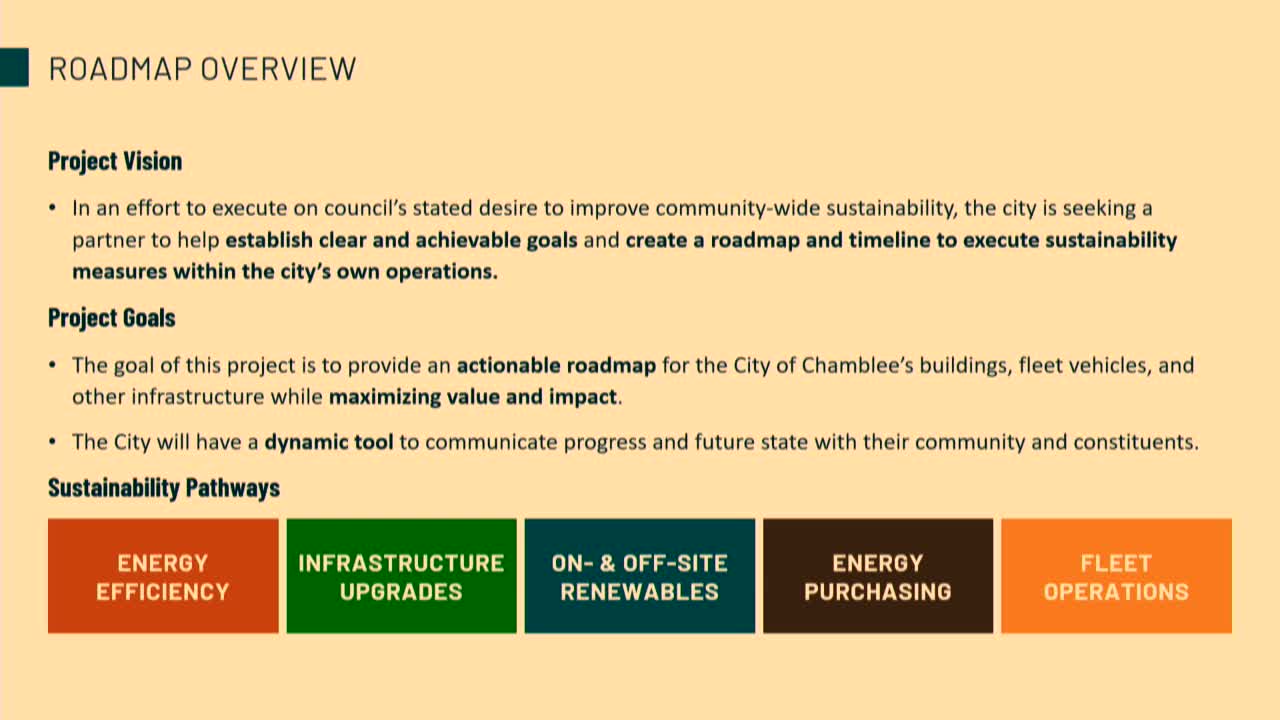City outlines ambitious roadmap for sustainable future
October 10, 2024 | Chamblee, DeKalb County, Georgia
This article was created by AI summarizing key points discussed. AI makes mistakes, so for full details and context, please refer to the video of the full meeting. Please report any errors so we can fix them. Report an error »

In a recent government meeting, city officials discussed the implementation of sustainability goals aimed at reducing emissions and enhancing energy efficiency within municipal operations. The conversation highlighted the need for realistic and actionable targets, as some communities have faced challenges in meeting overly ambitious sustainability objectives.
The city aims to create a tangible roadmap that focuses on its own operations, emphasizing the importance of leading by example. Key guiding principles for the sustainability initiative include high integrity, visibility, fiscal responsibility, and the use of proven technologies. Officials stressed the importance of setting achievable goals that are not only environmentally sound but also financially viable.
Current emissions data revealed that approximately 68% of the city's emissions stem from fuel usage, with electricity accounting for 29% and natural gas for 3%. The discussion also pointed out that the public safety sector is the largest consumer of fuel, primarily due to its fleet operations.
To address these emissions, the city is exploring three core strategies: improving efficiency, electrifying facilities and vehicles, and investing in on-site renewable energy sources, particularly solar power. The Inflation Reduction Act has made solar investments more financially attractive, allowing cities to benefit from direct tax credits.
The proposed plan includes a phased approach to implementing renewable energy solutions, with an expected investment of around $15.3 million. This investment is projected to yield significant long-term savings, estimated at $9 million over the lifespan of the assets, alongside potential incentives ranging from $2.3 to $3 million.
Overall, the city anticipates a 35% reduction in carbon emissions by 2029, primarily through efficiency improvements and the transition to renewable energy. However, the public safety fleet remains a significant barrier to achieving more ambitious net-zero goals, as discussions continue on transitioning patrol vehicles to electric options. The meeting underscored the city's commitment to sustainability while balancing fiscal responsibility and community engagement.
The city aims to create a tangible roadmap that focuses on its own operations, emphasizing the importance of leading by example. Key guiding principles for the sustainability initiative include high integrity, visibility, fiscal responsibility, and the use of proven technologies. Officials stressed the importance of setting achievable goals that are not only environmentally sound but also financially viable.
Current emissions data revealed that approximately 68% of the city's emissions stem from fuel usage, with electricity accounting for 29% and natural gas for 3%. The discussion also pointed out that the public safety sector is the largest consumer of fuel, primarily due to its fleet operations.
To address these emissions, the city is exploring three core strategies: improving efficiency, electrifying facilities and vehicles, and investing in on-site renewable energy sources, particularly solar power. The Inflation Reduction Act has made solar investments more financially attractive, allowing cities to benefit from direct tax credits.
The proposed plan includes a phased approach to implementing renewable energy solutions, with an expected investment of around $15.3 million. This investment is projected to yield significant long-term savings, estimated at $9 million over the lifespan of the assets, alongside potential incentives ranging from $2.3 to $3 million.
Overall, the city anticipates a 35% reduction in carbon emissions by 2029, primarily through efficiency improvements and the transition to renewable energy. However, the public safety fleet remains a significant barrier to achieving more ambitious net-zero goals, as discussions continue on transitioning patrol vehicles to electric options. The meeting underscored the city's commitment to sustainability while balancing fiscal responsibility and community engagement.
View full meeting
This article is based on a recent meeting—watch the full video and explore the complete transcript for deeper insights into the discussion.
View full meeting
